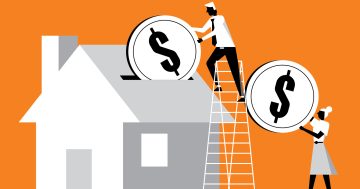Steve McKnight* offers advice on how to save more without an increase to your income.
 It might sound a little old-fashioned, but my Grandad really did know best when he said ‘the secret to saving more is spending less’.
It might sound a little old-fashioned, but my Grandad really did know best when he said ‘the secret to saving more is spending less’.
Most working Australians don’t have an earning problem, they have a spending problem.
If your spending is equal to or above your income then the money you attract won’t stick and will slip through your fingers.
Sure, you may maintain the materialistic appearance of wealth – nice car, nice house, nice clothes… while you’re still working, but when your income stops then your lack of savings and investments could cause you to become reliant on welfare to survive.
One way people seek to overcome a lack of savings is to earn more income.
This will work provided you don’t also increase your spending or use your extra income to borrow more money.
Many people lack the discipline to do so though, so their bigger paypackets are used to unlock a better standard of living, which locks in higher spending and no extra savings.
Earning, spending and saving
Being in control of your finances requires that you know three things: how much you earn, how much you spend, and how much you save.
Earning
How much you earn might sound simple enough, but there is a complication.
You earn gross dollars, but bank net dollars.
That is, income tax, superannuation and other payroll deductions are subtracted by your employer from your gross pay; you receive the ‘net’ of what’s left.
Spending gross pay but receiving net pay is a trap that causes people to leak money.
Their reference for spending is their annual gross income, not their actual net pay.
For instance, if your salary is $60,000 you might reasonably think you have that much buying power.
Wrong! After deductions, you’ll only bank $48,933.
If you spend based on earning $60,000 then you’ll need to use debt to bridge the gap.
Spending
If your spending isn’t under control, then it’s out of control, and that’s a problem because runaway spending repels money.
To fix the problem, try using allowances (they’re friendlier than budgets).
A simple allowance is the 80–20 rule, where you’re allowed to spend 80 per cent (of your net income!), so long as you save 20 per cent.
A more advanced (and recommended) rule is my 70–20–10.
Once you deduct compulsory deductions and giving (causes that add significance to your life) from your gross salary, the remainder is split: 70 per cent to spending, 20 per cent to savings and 10 per cent to accelerated debt repayment.
Once your debts are repaid then redirect that extra 10 per cent to savings.
Saving
You won’t get rich by saving, but you can’t get rich without saving.
Savings are a store of wealth rather than a source of wealth, because they don’t earn capital gains and the income return is low, even negative, after deducting tax and inflation.
Savings are rainy day reserves, and capital available to invest so you can multiply your money and build wealth faster.
Spending less to keep more
Spending less will build wealth faster than earning more.
How? Because a dollar earned has income tax deducted, but a dollar saved doesn’t.
For example, Bob needs an extra $100.
Assuming he pays 30 per cent income tax, he’d need to earn $143 gross to end up with $100 net (of tax).
Alternatively, he could cut back on his personal spending, where every dollar saved is a dollar kept since reducing personal spending has no income tax effect; $100 not spent equals $100 saved.
How do you willingly spend less?
Spending less money usually comes at the cost of sacrificing (choosing to miss out entirely) or delayed gratification (choosing to have it later).
It’s not easy to do this because going without is contrary to the more popular instant-gratification way of living.
The secret to willingly spend less now is to want something else more later.
You can’t change and stay the same.
To change your spending outcomes, you have to change your spending habits.
Everyone has something different that will trigger their motivation to change their saving and spending habits.
Finding your trigger and keeping the motivation switch ‘on’ (saving) even when you feel like it would be okay to turn it ‘off’ (spending) is necessary if you want to transition from okay to good, and from good to great.
Unless you find compelling reasons that provide sufficient momentum to push through the pain barrier of change, you’re only likely to make partial, rather than permanent, progress.
Spending hacks
Concentrate on saving dollars off your larger spends, rather than cents off your smaller ones.
Look for ways you might be being charged a lazy tax – unnecessarily high interest on your home loan, redundant excess pricing on energy providers and insurance, etc.
Engage the services of a mortgage broker to see if they can find a lower interest rate loan.
If they can, ask your current lender to match it, and if they won’t, move your business.
When it comes to power, make it a rule to price shop at least once a year.
Power providers are always dangling incentives and lower prices to get new sign-ups, and then hope you prefer the convenience of sticking with them rather than shopping round.
This is the same for insurance.
Price shop your home and car insurance annually to see if you can get a better deal.
Before changing, ask your current provider to price match, and if they can’t or won’t, then move.
Yes, it may take effort to shop around, but remember an extra dollar saved is an extra dollar kept.
Most people have a spending problem, not an earning problem.
If you want to increase your savings, master the habit of controlling your spending.
It will be easier to spend less than it will be to earn more.
Edited extract from *Steve McKnight’s Money Magnet: How to Attract and Keep a Fortune that Counts, now available at all leading retailers. Further information at www.moneymagnet.au.











